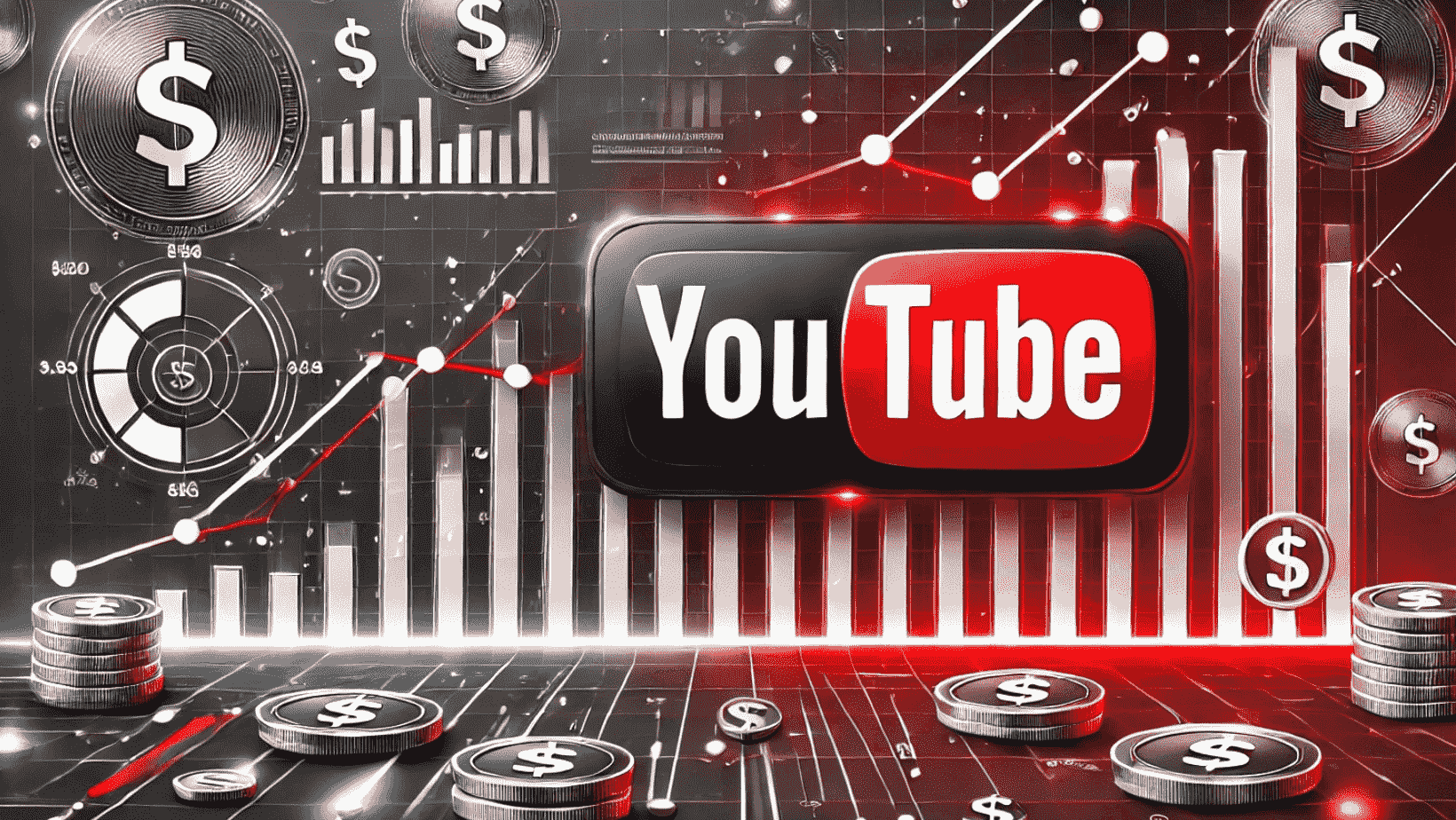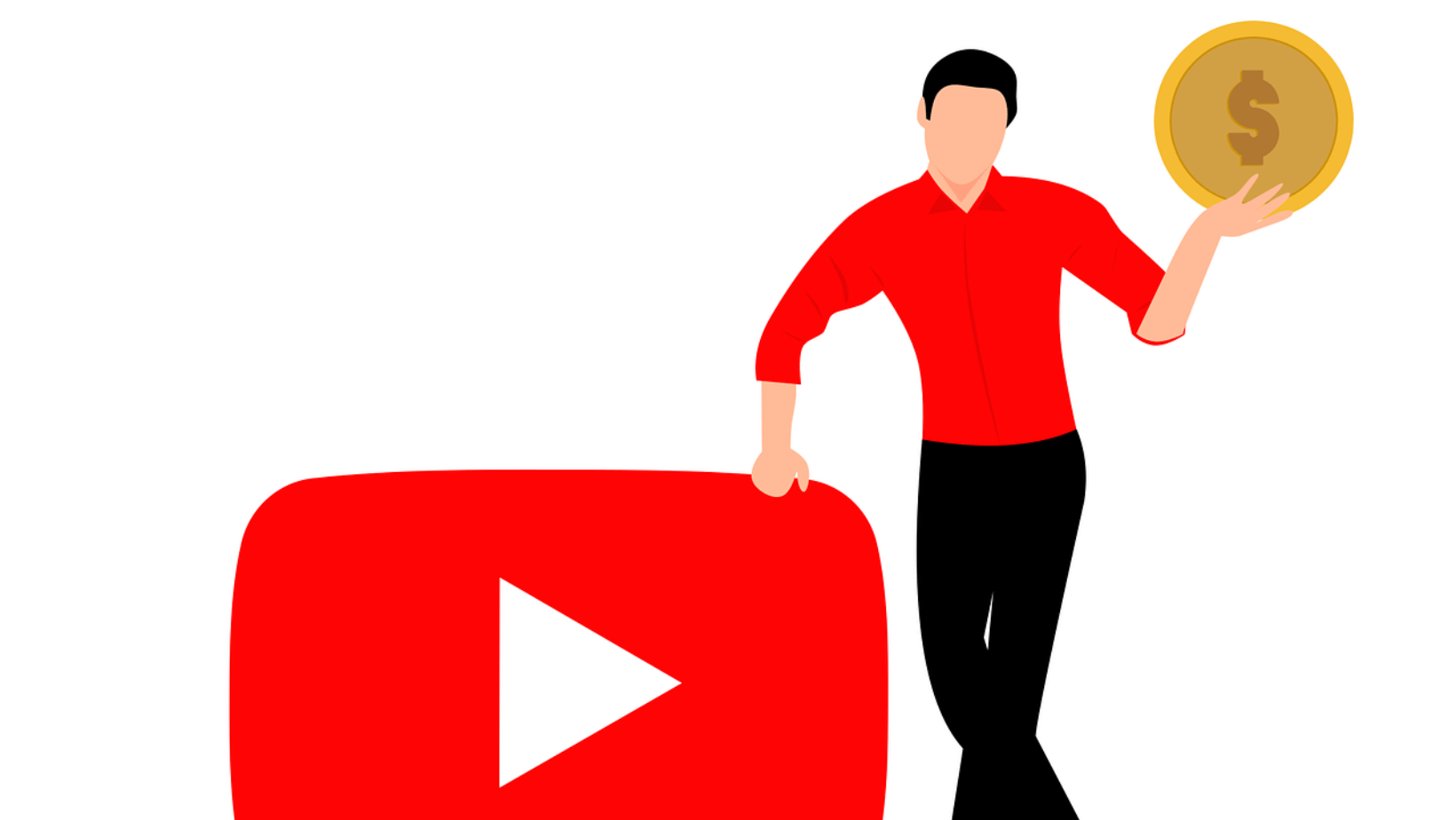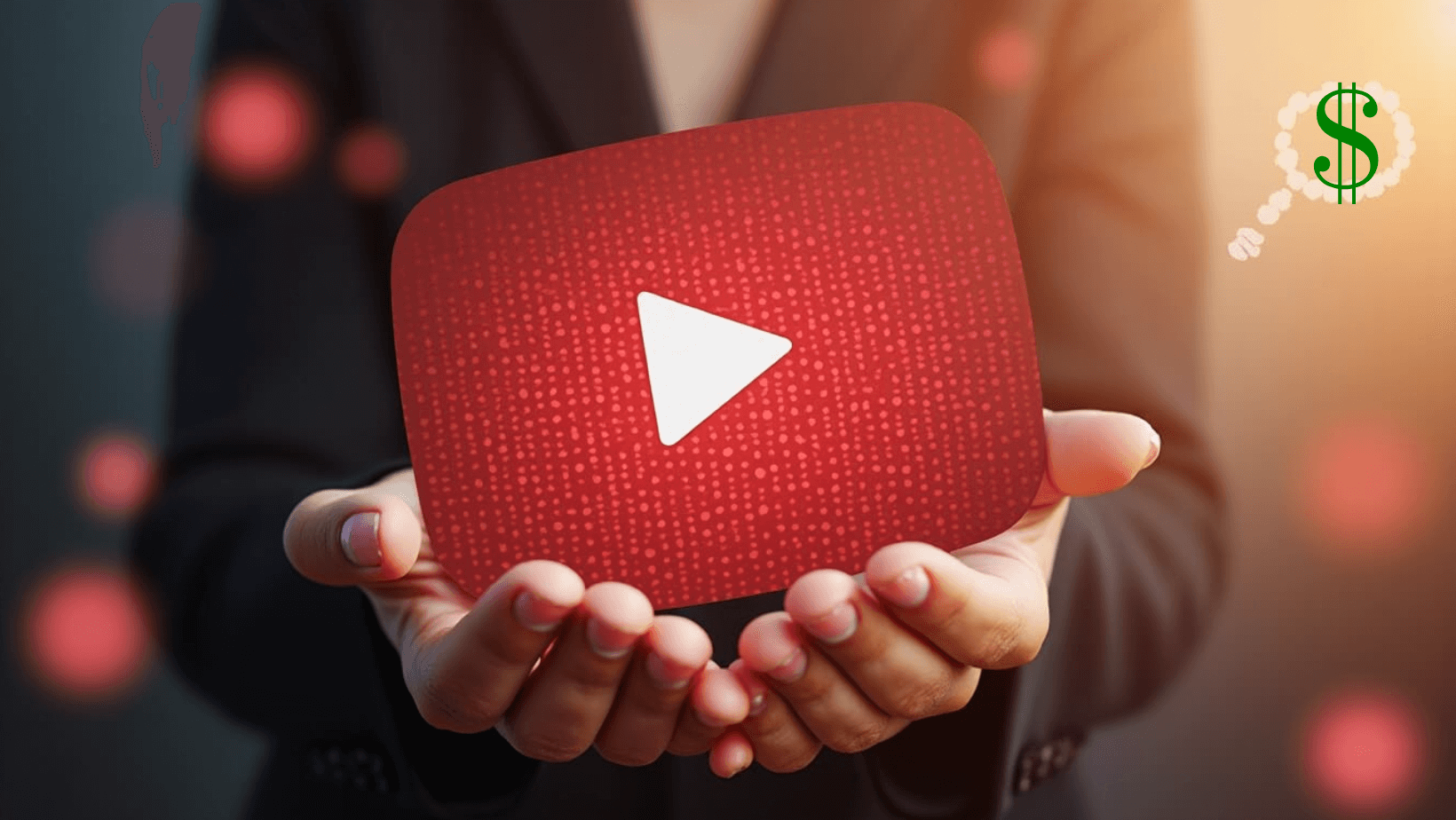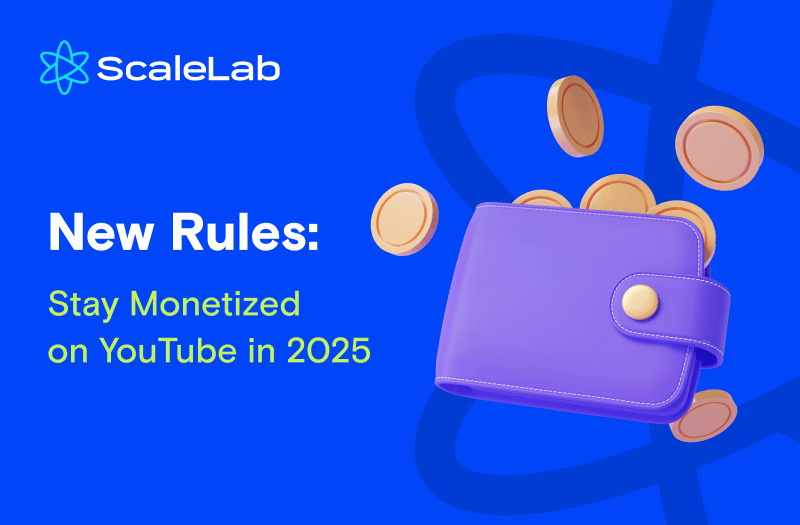If you’ve been creating content on YouTube for a while, you already know how the platform operates: policies shift, algorithms evolve, and monetization strategies must adapt. The new YouTube monetization rules bring both fresh opportunities and new challenges. If you’re not keeping up, you risk losing revenue – or worse, getting demonetized altogether.
We’ve analyzed the latest updates straight from YouTube’s official announcements, along with insider information from our experts on what’s coming next. Let’s break it down so you can stay ahead.
ScaleLab works with creators who stay compliant and want to maximize their revenue potential. In this article, we’ll break down the latest YouTube monetization policy changes, including key updates for Shorts, the evolving role of AI, and the ongoing impact of YouTube’s demonetization policies.

Monetization Rules for Creators in 2024
Before we dive into YouTube monetization in 2025, let’s take a step back and look at where we are now. The 2024 monetization policies laid the groundwork for what’s coming next. Last year, YouTube lowered the entry barrier for monetization, allowing smaller creators to join the YouTube Partner Program (YPP) sooner. The adjusted thresholds required only 500 subscribers and 3,000 watch hours or 3 million Shorts views within 90 days.
For established creators, YouTube pushed new ways to monetize beyond ads. Shopping features expanded, allowing creators to sell directly within videos. Live-streaming super features like Super Chat, Super Stickers, and Super Thanks saw increased adoption. However, demonetization remained a major concern, with more channels getting flagged for repetitive content, reused media, or controversial topics.
The foundation of YouTube monetization remains rooted in its long-established requirements. YouTube monetization rules 2025 will continue to refine expectations, ensuring that only high-quality, original content qualifies for revenue generation. Shorts monetization is now fully integrated into the broader system, but the revenue potential remains lower than long-form videos. For those depending on Shorts, additional monetization options like YouTube Shopping and fan funding are becoming essential revenue streams.
One of the more critical updates relates to AI-generated content. YouTube rules for monetization have been adjusted to limit the earnings potential of videos that heavily rely on AI-generated voices, images, or scripts. The YouTube demonetization policy now explicitly states that content with minimal human contribution will not be eligible for full ad revenue. If you’ve been utilizing AI tools, careful integration with original commentary and insights is required to maintain eligibility.
YouTube is generally not against AI tools and, moreover, it is also introducing such tools, such as AI Dubbing, AI Comment Moderation, and more. So, AI should be used as an additional help, but not as a substitute for everything.
Policy for YouTube Shorts Monetization
Shorts have been a gold rush, but monetizing Shorts isn’t as lucrative as long-form videos. While Shorts attract billions of views daily, the revenue-sharing model distributes ad earnings from a global pool, leading to lower RPMs compared to traditional video ads. So there are shifts, because we can see from the analytics of 3000 channels that PRM on YouTube Shorts rose in 2024.
Short-form video content continues to shape YouTube’s ecosystem, and YouTube Shorts monetization rules have been under constant revision. The revenue generated through the Shorts feed remains significantly lower than traditional long-form content, largely because YouTube’s advertising system prioritizes watch-time engagement. Shorts creators who rely solely on ad revenue will need to look beyond the YouTube monetization policy and tap into alternative streams like memberships, sponsorships, and direct product sales.
Interestingly, YouTube is experimenting with the integration of longer videos into the Shorts feed, which could blur the lines between formats. This shift suggests that YouTube rules and regulations are heading towards a more unified content strategy, where both short and long videos coexist more seamlessly within the recommendation algorithm.
YouTube is making a lot of innovations now, so the stakes are rising and you need to try them now.
Create YouTube Shorts with Collab
Collab lets creators record Shorts alongside other YouTube or Shorts videos in a side-by-side layout, fostering collaboration and attracting new viewers.
Q&A Stickers
Q&A stickers let creators ask questions within Shorts, boosting engagement and helping tailor content to audience preferences.
Go Live
Vertical live streaming on Shorts helps creators reach new audiences, earn via Super Chats and memberships, and interact in real-time.
YouTube is also integrating more in-stream ads within the Shorts feed, an effort to boost monetization potential. If you rely on Shorts, now is the time to experiment with formats that retain viewers longer and increase audience interaction, as these will likely weigh more in revenue calculations.

Monetization Policy Changes We Expect in 2025
YouTube has already hinted at its “big bets” for the future, and monetization is at the center of these shifts. Here’s what we anticipate:
1. AI-Generated Content and Monetization Restrictions
AI is both a blessing and a challenge for creators. In 2025, YouTube can introduce stricter guidelines on AI-generated content, particularly for monetization. Creators using AI tools already need to clearly disclose AI-generated elements, and some AI-assisted videos may be excluded from ad revenue sharing altogether. If you’re using AI to generate scripts, voiceovers, or visuals, be prepared to prove that your content adds value beyond simple automation.
2. Expanded Revenue Streams Beyond Ads
YouTube is actively pushing creators toward diversified revenue models. Shopping, memberships, and direct audience funding will play an even bigger role in 2025. The number of creators making five figures from non-ad sources is growing fast and that number is expected to grow more. We can expect more integrations between YouTube and e-commerce platforms, making it easier for creators to turn their channels into full-fledged businesses.
3. Demonetization Crackdowns and Content Classification
YouTube has become more firm in demonetizing channels that violate its advertiser-friendly guidelines. In 2025, there are expectations of even tighter enforcement of policies on sensitive topics, including politics, health misinformation, and excessive reuse of content. If your channel has been hit with demonetization before, it’s time for a deep audit. Make sure your metadata, titles, and video descriptions don’t trigger policy flags.
Reach out to us for a detailed channel audit – we’ll help you uncover what’s holding you back and create an actionable plan to fix it.
4. More Control Over Ad Placements
Creators have long requested better ad controls, and YouTube is responding. In 2025, we expect more options to customize how ads appear on your videos.
Expect stricter enforcement of YouTube rules as the platform increases its scrutiny of reused, misleading, or mass-produced content. The emphasis on originality is stronger than ever. Monetization rules YouTube is implementing now require a higher level of audience retention, ensuring that creators are producing engaging content rather than relying on quick-click tactics. Returning viewer rates have become a critical metric in determining a channel’s monetization eligibility.
The YouTube Shorts policy also reflects this change, requiring higher engagement levels for continued monetization. Additionally, new AI-driven detection tools are being used to identify potential policy violations faster than ever before. If your content does not align with YouTube’s evolving quality standards, you may find yourself struggling to maintain monetization eligibility.
What to Do to Avoid Demonetization in 2025
Demonetization is a creator’s nightmare – one strike, and your income can take a massive hit. Here’s what you need to focus on to keep your revenue safe:
- Audit Your Content
Identify videos that might violate new guidelines, especially AI-generated or repetitive content.
- Engagement Over Clickbait
YouTube is rewarding retention and genuine interaction more than ever. Ensure your videos encourage real audience participation.
- Diversify Revenue Streams
Ad revenue is great, but don’t rely solely on it. Use memberships, Super Chats, and product integrations to build financial stability.
- Stay Updated
YouTube’s policies change frequently. Keeping up with updates is key to long-term success.
Understanding YouTube monetization requirements is now more crucial than ever. Content that is repetitive, lacks original commentary, or falls into low-engagement categories faces higher risks of demonetization. The latest YouTube monetization policy 2025 updates indicate that reused content will be subject to even stricter scrutiny. If your channel has previously relied on compilation-style videos or repurposed clips, it is time to rethink your content strategy.
Another important aspect of how YouTube monetization works is the diversification of income sources. Ad revenue alone is no longer a sustainable strategy, especially for Shorts-focused creators. YouTube is actively encouraging monetization strategies beyond advertising, such as shopping integrations, memberships, and fan funding. YouTube's new monetization policy highlights the platform’s shift towards fostering long-term creator sustainability through these diversified earning models.
If you’re struggling to keep up with policy shifts or need help optimizing your monetization strategy, ScaleLab offers expert consultations, monetization audits, and growth strategies that ensure you stay ahead of the curve. Contact us today!
Tips to Keep Earning on YouTube
To stay profitable on YouTube in 2025, you need to adapt. Some practical moves include:
- Optimize Shorts for Monetization
Longer Shorts (closer to 3 minutes) with strong engagement are expected to perform better for revenue in 2025.
- Leverage Shopping Features
If you’re not using YouTube Shopping, you’re leaving money on the table. Start integrating product promotions into your videos.
- Enhance Video Quality
AI tools can help streamline production, but human creativity and unique storytelling still win.
- Use YouTube’s New Ad Features
Take advantage of updated ad placement controls to maximize earnings without overloading your audience with interruptions.
The platform is continuously refining its monetization YouTube framework, and staying ahead requires proactive adaptation. With tighter restrictions on content quality, stronger enforcement of advertiser-friendly guidelines, and the growing role of alternative revenue streams, creators must evolve their strategies accordingly. Relying solely on traditional ad revenue is becoming a less viable option, especially as YouTube Shorts rules evolve.
Looking ahead, YouTube monetization rules 2025 will likely continue prioritizing long-term engagement and viewer retention. Whether through long-form content, Shorts, or hybrid formats, ensuring audience loyalty is the best way to maintain stable earnings. As YouTube continues integrating AI-based moderation and policy enforcement, creators must remain aware of how these technologies impact their content and revenue potential.

ScaleLab provides expert guidance on navigating YouTube’s changing policies, optimizing content for maximum earnings, and diversifying income streams. Join ScaleLab today and stay ahead of the game!
